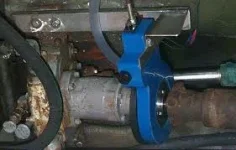MarioG
Legendary Member
- Joined
- Apr 12, 2005
- Messages
- 1,440
- Status
- OWNER - I own a Hatteras Yacht
- Hatteras Model
- 58' YACHT FISHERMAN (1970 - 1981)
Right off the bat, lets assume resale value is not a factor or a care for this discussion.
Lets take my boat as an example,
1972 58' Hatteras Yachtfisherman, DD 8v71tis 435 HP. aprox. 3000 hours SMO. Semi displacement hull. boat is about 75,000 lbs currently.
We have had our boat for about 3 years now. we use it extensively but mostly for bay cruising and the keys. when able, we cruise the Bahamas. our boat has hardly ever been above 12 knots and rarely on plain. Simply put we use her mostly like a trawler. a good reason for this is because of the high price of fuel and because this boat in reality isn't very fast even on plain by today standards. But mainly we prefer a slower pace. Our future but far away plans of our boat (god willing) is to retire and become permanant cruisers. Our boat was designed during a era of really cheap fuel which was measured in cents and not dollars a gallon. the people that were able to own these boats back then and which still applies to some today, could afford to go through fuel and overhauls with little care.
I have always wondered about what it would be like to install smaller engines into our boat. mind you that I understand that it is cheaper to overhaul what I currently have. but lets look at it from efficiency and application point of view. our engines are rated at 435 HP but I operate the boat at about 8 to 10 kts on average. I don't know exactly how much HP I may be usuing but it coulden't be much more than 150 to 200 hp at best to cruise at 8 to 10 kts. Its is well known and argued to exaustion that operating these engines at low power is not good. Some say powering up once in a while makes sense. But what if the proper engines rated for slow cruise application was installed like 6/71 or 4/71 naturals or any other simple low maintanance engine rated to lets say 250 HP of continous duty and bigger props and proper gear ratios. would this lower fuel consumption and extend engine life? how about ease of maintanance? removing a giant engine like an 8v71 and replacing it with a smaller 4 or 6 inline opens up massive real estate in the engine room. Although reducing overall engine weight would help, I guess it would be a wash because ballast weight would have to be added due to stability issues. it seems that a boat like ours would benefit in our application but What am I missing?
Lets take my boat as an example,
1972 58' Hatteras Yachtfisherman, DD 8v71tis 435 HP. aprox. 3000 hours SMO. Semi displacement hull. boat is about 75,000 lbs currently.
We have had our boat for about 3 years now. we use it extensively but mostly for bay cruising and the keys. when able, we cruise the Bahamas. our boat has hardly ever been above 12 knots and rarely on plain. Simply put we use her mostly like a trawler. a good reason for this is because of the high price of fuel and because this boat in reality isn't very fast even on plain by today standards. But mainly we prefer a slower pace. Our future but far away plans of our boat (god willing) is to retire and become permanant cruisers. Our boat was designed during a era of really cheap fuel which was measured in cents and not dollars a gallon. the people that were able to own these boats back then and which still applies to some today, could afford to go through fuel and overhauls with little care.
I have always wondered about what it would be like to install smaller engines into our boat. mind you that I understand that it is cheaper to overhaul what I currently have. but lets look at it from efficiency and application point of view. our engines are rated at 435 HP but I operate the boat at about 8 to 10 kts on average. I don't know exactly how much HP I may be usuing but it coulden't be much more than 150 to 200 hp at best to cruise at 8 to 10 kts. Its is well known and argued to exaustion that operating these engines at low power is not good. Some say powering up once in a while makes sense. But what if the proper engines rated for slow cruise application was installed like 6/71 or 4/71 naturals or any other simple low maintanance engine rated to lets say 250 HP of continous duty and bigger props and proper gear ratios. would this lower fuel consumption and extend engine life? how about ease of maintanance? removing a giant engine like an 8v71 and replacing it with a smaller 4 or 6 inline opens up massive real estate in the engine room. Although reducing overall engine weight would help, I guess it would be a wash because ballast weight would have to be added due to stability issues. it seems that a boat like ours would benefit in our application but What am I missing?


